According to the most recent Kavango-Zambezi Transfrontier Conservation Area (Kaza) survey, elephant populations are stable with a statistically insignificant growth rate of only 1.2% growth per year – an enormous contradiction to Botswana’s claim of 6% annual growth and Zimbabwe’s claims of 5% to 8% annual growth.
However, Elephants Without Borders’ (EWB) recently released a technical review of the Kaza elephant survey reveals that trends in some populations are indeed highly concerning, with poaching and hunting altering elephant distribution and threatening their safety across Africa’s elephant stronghold.
The review notes that while “Kaza’s elephant population appears to be relatively stable overall, the results for Zambia, Botswana and Angola show worrisome indications, including high carcass ratios, large declines, and evidence of recent poaching. These areas should have high priority for future monitoring.”
The technical report contradicts claims of overpopulation by revealing the high carcass ratio found during the elephant surveys across the Kaza region. A carcass ratio of 8% or higher suggests a declining population in which deaths exceed birth rates. The carcass ratio has grown from 8% to 11%, potentially indicating unsustainable mortality rates.
Botswana has threatened to send 10,000 elephants to Hyde Park and now another 20,000 to Germany as UK and European countries continue to debate the import of hunting trophies. According to Botswana’s President Mokgweetsi Masisi, Botswana is heavily overpopulated by elephants, which he believes requires trophy hunting to control.
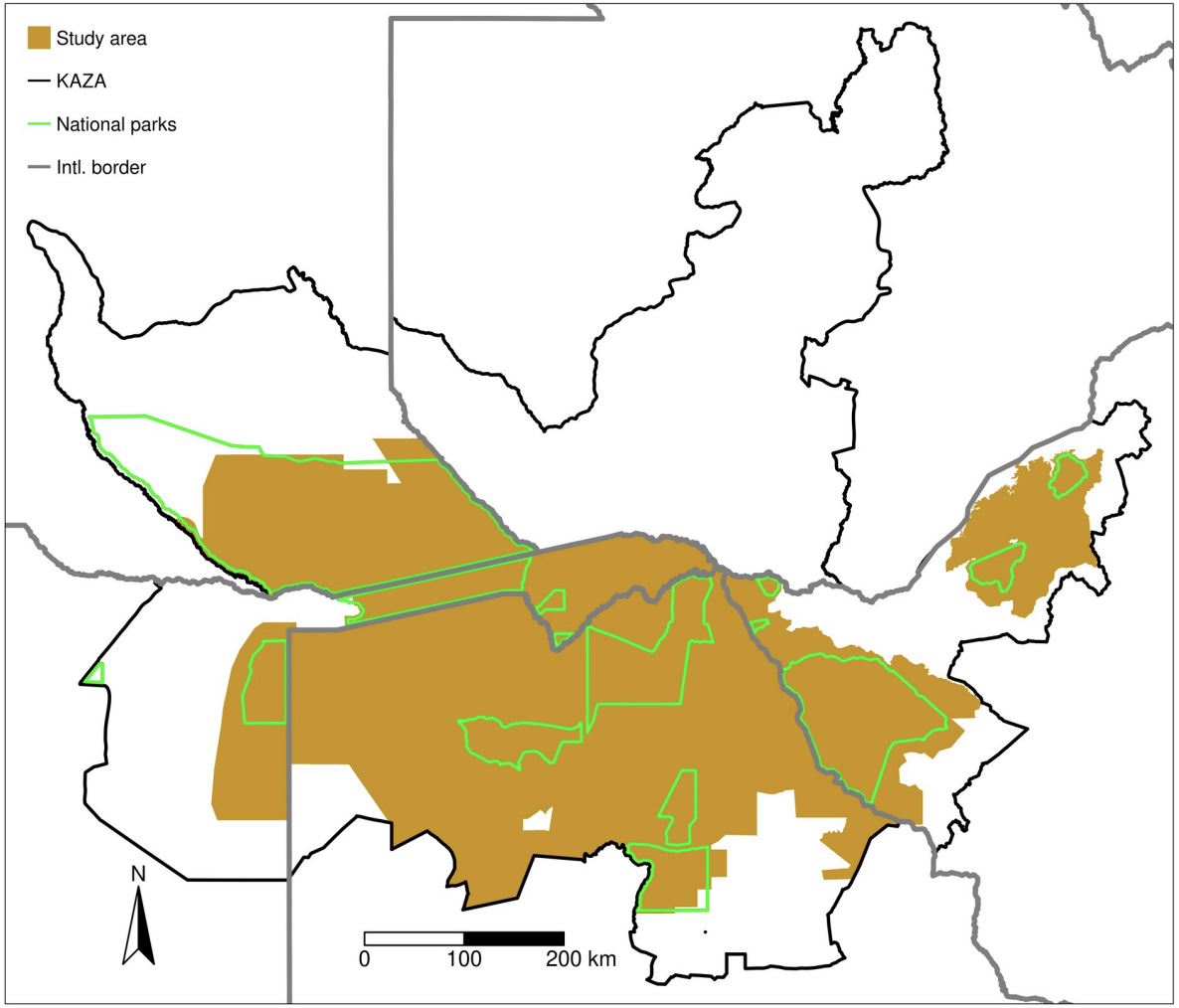
The Elephants Without Borders study area spanning Namibia, Angola, Botswana, Zambia, Zimbabwe. (Source: Elephants Without Borders)
The Kaza region remains a critical stronghold for Africa’s savannah elephant population, with the latest survey data indicating about 228,000 elephants – just over half of Africa’s savannah elephants.
Botswana
The EWB review notes that elephant numbers in Botswana have increased by 1.3% since the last survey, increasing in national parks and other protected areas, especially in the Okavango, but decreasing in pastoral and agricultural areas, “in contrast to the Botswana government’s claim of 7.6% growth per year”.
Crucially, “numbers of elephants decreased by 25% in areas that were open to hunting and increased by 28% in areas where hunting is not allowed”.
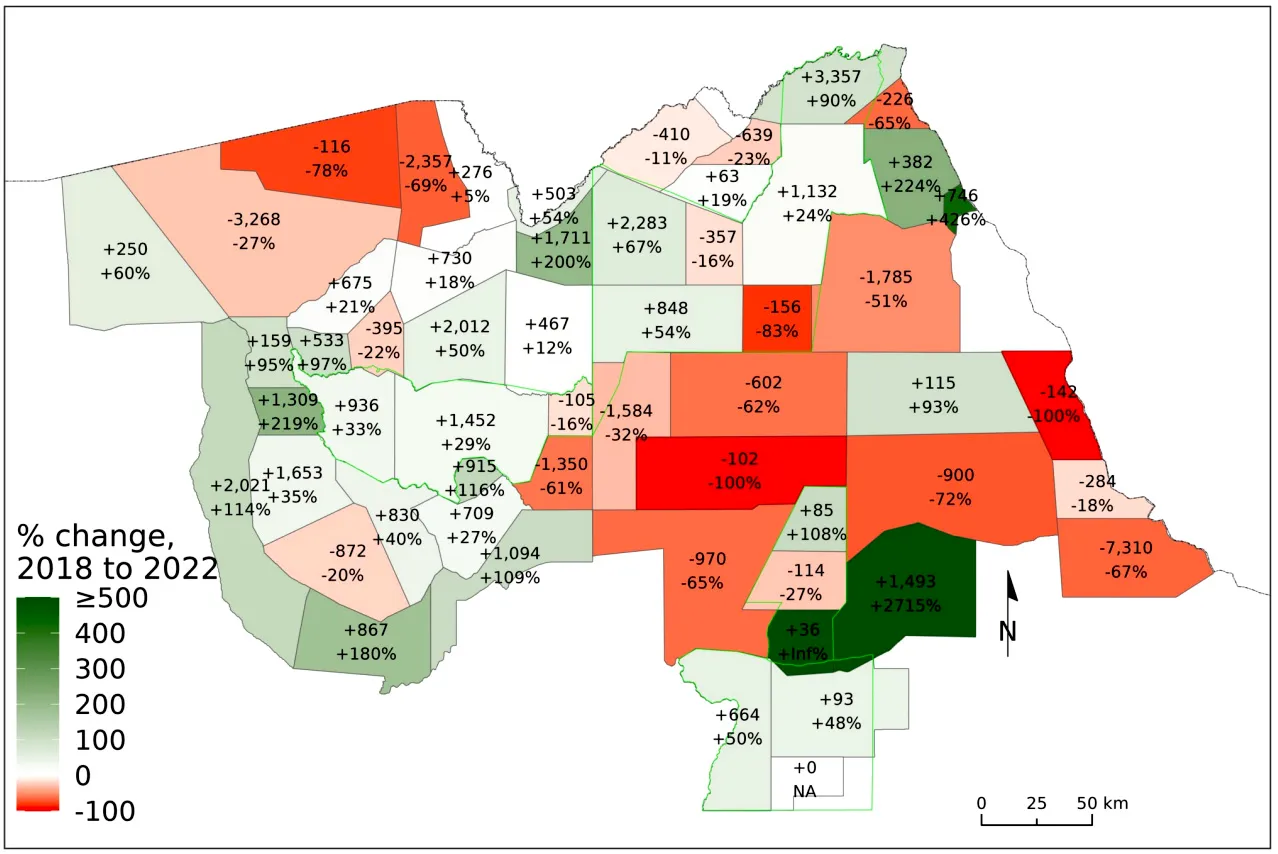
Despite claims regarding a rapidly increasing elephant population, northern Botswana has seen declines of more than 50% in 12 areas between 2018 and 2022. (Source: Elephants Without Borders)
Between October 2023 and February 2024, 56 poached carcasses were located in northern Botswana, which is likely to be an underrepresentation of the true number of poached elephants, highlighting fears that Botswana’s northern regions are becoming a poaching hotspot. According to reports, the poachers are targeting elephants in Botswana before smuggling the tusks into Zambia.
According to Elephants Without Borders, 2022 saw the highest fresh carcass ratio in Botswana, further contradicting claims of a population explosion and no poaching. Just last month, 651 elephant tusks were seized in Maputo, Mozambique, and are likely to have been poached from elephants in neighbouring countries.
The technical review raises concerns that “Kaza contains only seven sites for the Monitoring the Illegal Killing of Elephants (MIKE) programme, which collects data on poaching from ranger patrols. Of the seven sites, four began operation in 2018 or later. This small sample is not sufficient for estimating poaching rates in an area of over 500,000km². More monitoring of poaching is badly needed in Kaza.”
Zimbabwe
No significant changes were observed in Zimbabwe (see image below) Again, the technical report by Elephants Without Borders contradicts unsubstantiated claims by Zimbabwe at a conference to promote ivory trade that its population is growing unsustainably at 5% to 8% annually. Environmental authorities had previously considered a mass cull of up to 50,000 elephants in 2021, about half of its population.
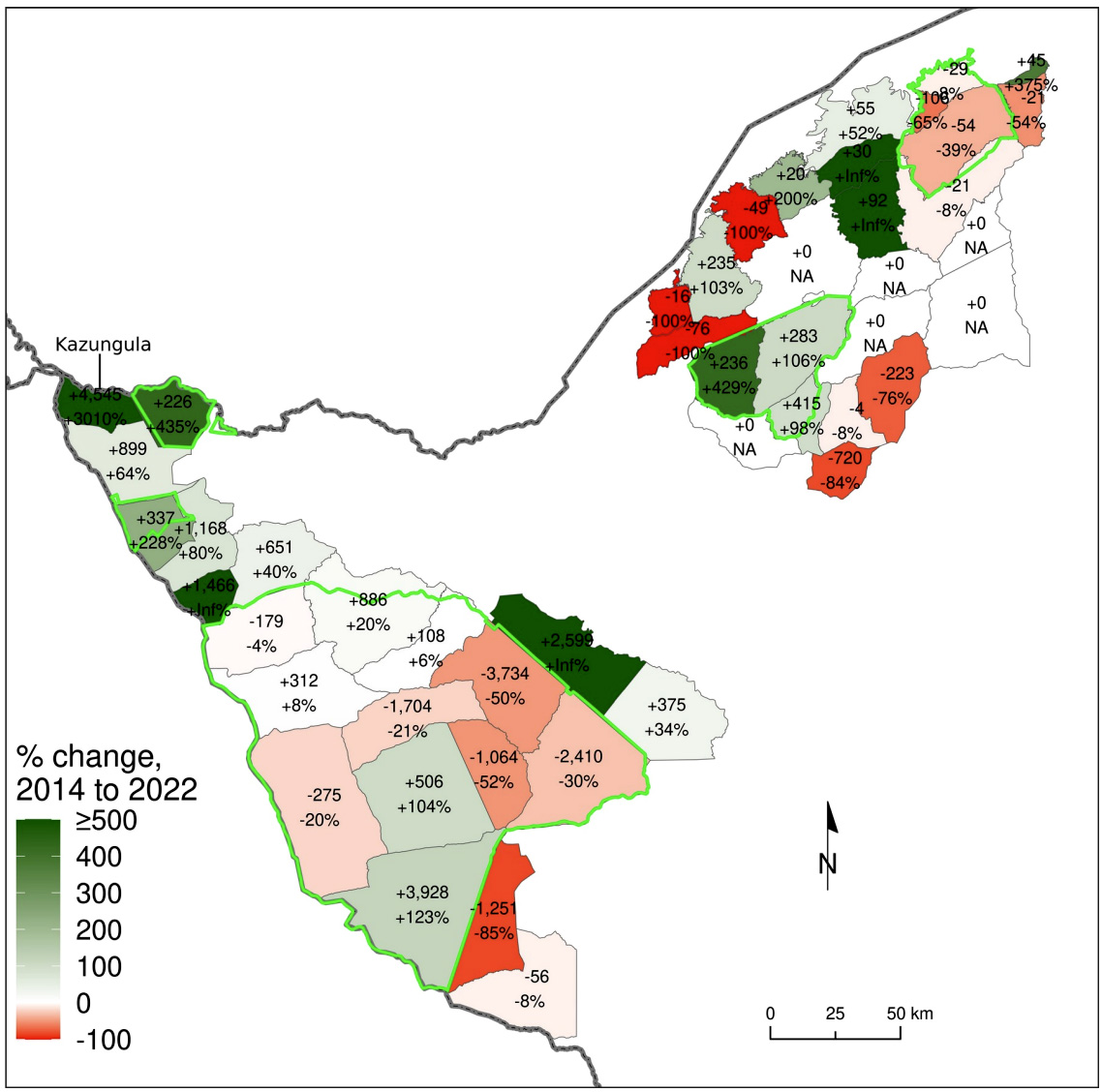
Fourteen areas in Zimbabwe demonstrate decreases in elephant numbers while only six demonstrate significant increases between 2014 and 2022. (Source: Elephants Without Borders)
Angola
There is considerable cause for concern regarding Angola’s elephants, as shown in the figure below. The technical report indicates an even higher carcass ratio of 16% in Angola, with 71% of observed carcasses being those of poached elephants. Such a high carcass ratio is concerningly symptomatic of an “attractive population sink” – elephants are “lured to dangerous areas where mortality exceeds natality, contributing to wider population losses”, according to report authors Scott Schlossberg and Mike Chase.
The authors posit that elephants are moving into Angola from the larger populations in Namibia and Botswana but are experiencing high mortality rates in Angola, possibly due to poaching.
This raises questions regarding Botswana’s expressed intention to send 8,000 elephants to Angola in an attempt to reduce its own population. Even if this were physically possible, the elephants are still able to freely move across the region.
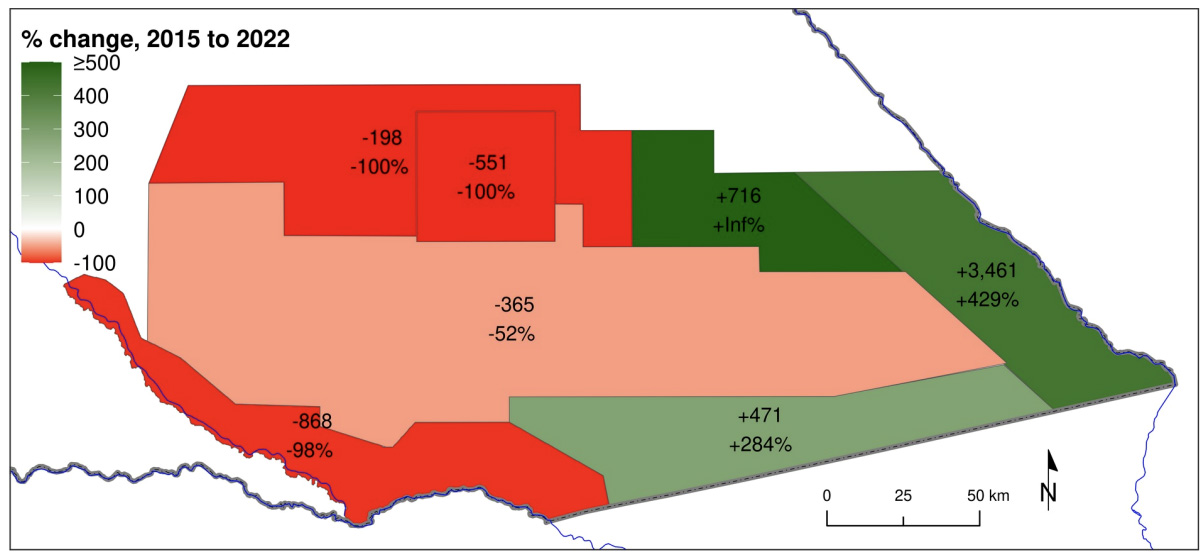
Southern Angola demonstrates concerning decreases in elephant populations between 2015 and 2022 in four out of seven regions. (Source: Elephants Without Borders)
Namibia
In Namibia, between 2015 and 2022, the elephant population decreased slightly and non-significantly in the Kavango-Zambezi region and increased non-significantly in Khaudum Nyae-Nyae. Notably, numbers of elephants declined along the Angola and Zambia borders in Kavango-Zambezi. In March 2024, Namibia published a tender for a hunting concession inside the Khaudum National Park.
Botswana trophy hunting debate
Botswana’s government continues to push a strong trophy hunting agenda. In a confusing contradiction, Environment and Tourism Minister Dumezweni Mthimkhulu likened trophy hunting to culling, which was later countered by President Masisi who called culling “ethically abhorrent” and “indiscriminate”.
Botswana reintroduced trophy hunting in 2019 following former president Ian Khama’s ban on sports hunting. Since this reintroduction, survey data indicate that elephant populations are decreasing in ranching, farming and hunting areas and increasing in core conservation areas, most likely as a result of elephant herds moving away from heavily disturbed environments. Trophy hunting cannot be viewed as sustainable if the population is not growing and poaching remains high.
A declaration dated 15 March 2024 has now extended Botswana’s open season on hunting elephants from 2 April 2024 until 31 January 2025. Typically, the hunting season would only last from mid-April to mid-September. The declaration has effectively added five additional months of hunting elephants.
Masisi cites high levels of human-elephant conflict due to burgeoning elephant populations as another reason to promote trophy hunting. However, this argument fails to hold up to scrutiny. Trophy-hunting mature bulls based on trophy-standard characteristics of maximum tusk size does not solve human-elephant conflict, according to the Environmental Investigation Agency’s Mary Rice.
In fact, failure to properly identify and demarcate elephant corridors and allowing hunting in established corridors, such as NG13, risks undermining access routes across transnational boundaries and creating further opportunities for human-elephant conflict to occur. Elephants Without Borders notably states that urgent re-evaluation is required of the effects of trophy hunting in dispersal corridors which are “critical to the Kaza vision of a connected landscape”.
If human-elephant conflict strategies have been implemented with success elsewhere and trophy hunting benefits for communities remain dubious, why push to promote trophy hunting in a country that has been lauded as a wildlife safe haven for so many years? There are claims in the media that this is an election strategy to distract attention from government failures.
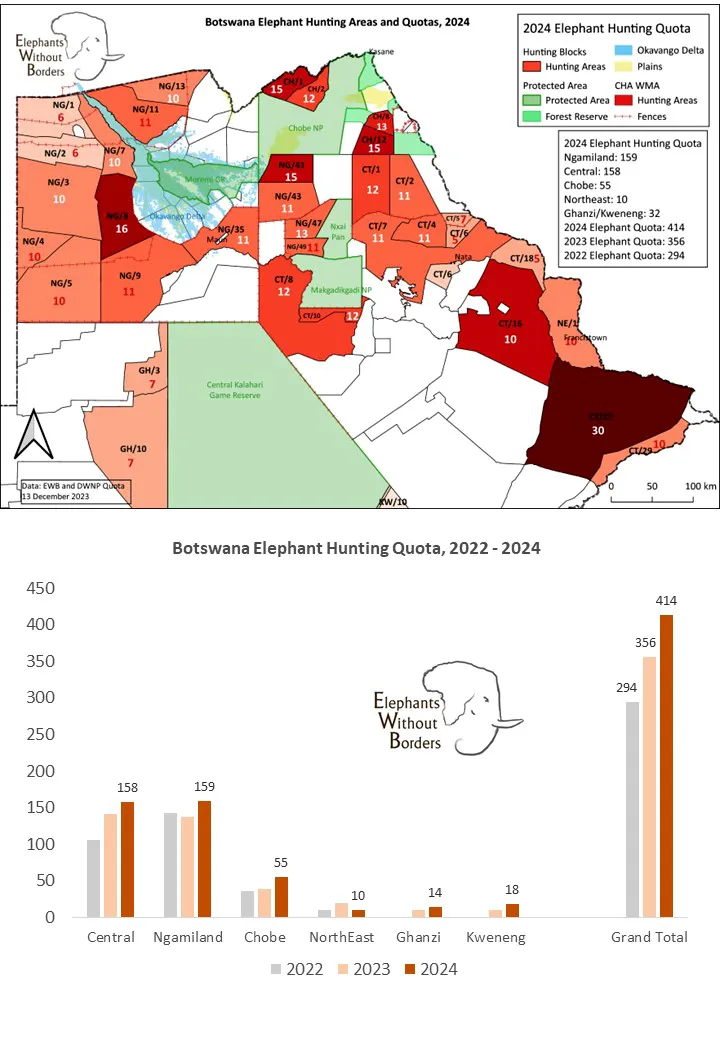
A significant increase in elephant hunting quotas from 2022 to 2024 for Botswana, with up to 30 elephants offered for hunts in a single region in 2024. (Source: Elephants Without Borders)
To fuel concerns, Botswana has yet to publicly share the scientific basis for its trophy hunting quota of 414 elephants for 2024 despite asserting it as a necessary solution.
Several myths regarding elephant populations are taken as scientific fact in certain government and public spheres and require critical scrutiny. One oft-touted myth is carrying capacity, which has again been used to justify ramping up elephant trophy hunting. The notion of carrying capacity was based initially on an outdated policy that lacked scientific backing to manage Hwange’s elephants.
However, researchers largely agree that the distribution of elephants in a landscape has far more relevance than the outdated concept of carrying capacity. The Kaza region offers opportunities for elephants to move across national boundaries, further making carrying capacity in a single country or sub-region irrelevant.
Trophy hunting, in any case, would not solve an overpopulation issue as it only targets the largest and most impressive specimens, effectively depleting the elephant population of its strongest genes. Selectively killing older bulls only serves to decimate genetic diversity. And if bulls beyond breeding age are trophy hunted, then this could never serve to control a supposed “overpopulation” of elephants.
As already demonstrated by the Elephants Without Borders report, trophy hunting and poaching have altered the distribution of elephants across the Kaza countries and even within Botswana’s landscapes, with herds avoiding areas disturbed by a hunting presence.
When science is ignored in favour of rhetoric and misinformation, it is more critical than ever to scrutinise how policy is shaped and who it prioritises. Biodiversity at large is increasingly threatened by overexploitation and unsustainable use. Greenwashing narratives of sustainability and conservation employing misinformation will only serve to harm Kaza’s critical elephant populations.
It is abundantly clear that further research is required to examine the impacts of trophy hunting on elephant populations, especially in light of high poaching statistics, and to better understand ways in which human-elephant conflict can be responsibly mitigated for people and wildlife. DM















Thank you for this in depth perspective.
The wrticle totally misses the point.
Trophy hunting will never reduce elephant populati9ns. It’s a method of getting an income from the elephants to offset the cost of giving the elephants so kuch land.
The other point was to demonstrate that countries without elephants shouldn’t be dictating to countries with successful elephant populations, how to manage their wildlife. Punit8ve sanctions, like trophy bans is patronizing colonialist behavior forcing an agenda on African countries that isn’t backed by science.
I am dumbfounded by the detail this article has gone to to create a distraction. I am also interested in what conservation psychology is. Surely the right people to talk to this topic would be habitat managers, ecologists and grass roots conservationists.
Again.. the exhausting article totally misses the point, and I am sure the writer knows that perfectly well, and comes from a deeply biased dogma, that has insisted that she creates a distraction.
Botswana offered elephants to Germany because they felt Germany was trying to dictate policy to them without a cooking clue what it’s like to live with elephants. Whether they offered 1 or 30 000 epelephants is immaterial. Because a single elephant roaming freely in Germany would cause quite a stir, but Botswana has in excess of 130000 elephants. Roughly one elephant for every 10 people.
I hope the writer of this article reads this comment, and gets made aware that many people can see that this is a deliberate distraction. I would question too, who funded this article.
Andrew…the good Doctor is a conservation psychologist (CP) and photographer. CP seeks to bring “social justice and and correct historical discrimination within the conservation movement and….etc, etc”, especially, in her case, through “photostory”. You couldn’t make it up…welcome to the modern world.
Elephants are charismatic animals that the public love to look at but know nothing about and that’s why they are an attractive bandwagon for every kind of animal rights, vegan, gun-phobe, NGO and greenwash campaign going. There bring unlimited public donations and “research” funding for this sort of academic stuff that has little to do with the real problems of real elephants in the real world, but everyone wants a slice of the pie. There is no money in reality and the real facts are too boring for publication. Wishbone vs backbone.
Meanwhile, if you live in remote Northern Botswana and a herd of hungry, angry elephants is trampling your precious food, demolishing your corn store, wrecking your borehole, flattening your relatives, preventing your kids from schooling and imposing a night-time curfew on your village, I am sure you you would find CP and photostory very, very comforting.
In passing, Doctor Klarmann is a well-known anti-hunter (see her article in DM on Jan 31st), and campaign organiser for Blood Lions. She is perfectly entitled to be so, but nobody in the Field Management of elephants would be stirred to reply. There are real things to attend to.
I am an active anti-poaching ranger for North West parks in South Africa. This article, although detailed seems like it was written and investigated behind a desk. The African elephant populations require nothing short of an entire continent to freely roam (migrate) through to follow the rains and fresh pastures. This is the reality. This is obviously short of impossible given the current human distribution and population index on the continent simply can’t support, nor is there money enough to support this, not that the money doesn’t exist, instead it’s being directed toward petitions on unnecessary hunting. When you look at a trophy hunt for an ubundant species that will truely add no further value than a cool take home . If used correctly as hunting is very selective, only non-gene pool critical individuals are sold for the purpose of hunting. What happens if it is banned in full, is that the local conservation authorities have no other option but to cull to ensure current populations have adequate food reserves to support themselves. That means it’s not just a bull here or there, but a quota for hundreds of heads in order to maintain sustainable healthy populations. One simply needs to take a look at Madikwe Game Reserve in the North west and you will see first hand what elephant overgrazing does for the ecology of an area, and the negative effects on the quality of life of the animals left behind.